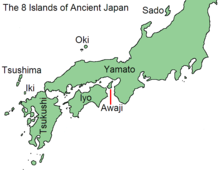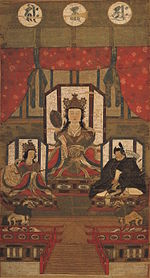Izanagi
| Izanagi-no-Mikoto | |
|---|---|
Primordial god of creation and life | |
Sendai Kuji Hongi | |
| Region | Japan |
| Personal information | |
| Parents | None (Kojiki, Nihon Shoki) Aokashikine-no-Mikoto (Shoki) Awanagi-no-Mikoto (Shoki) Omodaru and Ayakashikone) |
Izanagi (イザナギ/伊邪那岐/伊弉諾) or Izanaki (イザナキ), formally referred to with a divine honorific as Izanagi-no-Mikoto (伊邪那岐命/伊弉諾尊, meaning "He-who-invites" or the "Male-who-invites"), is the
Name
His name is given in the Kojiki (c. 712 AD) both as Izanagi-no-Kami (伊邪那岐神) and Izanagi-no-Mikoto (伊邪那岐命), while the Nihon Shoki (720 AD) refers to him as Izanagi-no-Mikoto, with the name written in different characters (伊弉諾尊).
The names Izanagi (Izanaki) and Izanami are often interpreted as being derived from the verb izanau (historical orthography izanafu) or iⁿzanap- from Western Old Japanese 'to invite', with -ki / -gi and -mi being taken as masculine and feminine suffixes, respectively.[2][3][4] The literal translation of Iⁿzanaŋgî and Iⁿzanamî are 'Male-who-invites' and 'Female-who-invites'.[5][6] Shiratori Kurakichi proposed an alternative theory which instead sees the root iza- (or rather isa-) to be derived from isao (historical orthography: isawo) meaning 'achievement' or 'merit'.[7]
The etymological origin of the verb is suggested to be a precursor to the Middle Korean lemma yènc- meaning 'to place/put on [the top of]' reconstructed as *yenc-a (place-INF) in Old Korean.[8] This does coincide with other related mythological figures related to a source in the Korean peninsula like Susanöwo.
Mythology

In the Kojiki
The birth of the land
The Kojiki portrays Izanagi and his younger twin sister Izanami as the seventh and final generation of deities that manifested after the emergence of the first group of gods, the Kotoamatsukami, when heaven and Earth came into existence.[9]
Receiving a command from the other gods to solidify and shape the Earth (which then "[resembled] floating oil and [drifted] like a jellyfish"), the couple use a

Izanagi and Izanami then decided to repeat the ritual, with Izanagi greeting Izanami first. This time, their union was a success, with Izanami giving birth to some of the various islands that comprise the Japanese archipelago (with the notable exceptions of Shikoku and Hokkaido), which include the following eight islands (in the following order):
- Awaji-no-Ho-no-Sawake (淡道之穂之狭別島)
- The double-named island of Iyo (伊予之二名島 Iyo-no-Futana-no-Shima, modern Shikoku)
- The triple islands of Oki (隠伎之三子島 Oki-no-Mitsugo-no-Shima)
- Tsukushi (筑紫島, modern Kyushu)
- Iki (伊伎島)
- Tsushima (津島)
- Sado (佐度島)
- Ōyamato-Toyoakitsushima (大倭豊秋津島, modern Honshu)[12]
The two then proceeded to beget the various deities who are to inhabit these lands.
Descent into Yomi
Izanagi, wishing to see Izanami again, went down to
Purification (Misogi)

Izanagi, feeling contaminated by his visit to Yomi, went to "[the plain of] Awagihara (i.e. a plain covered with
Izanagi and Susanoo
Izanagi divides the world among his three children: Amaterasu was allotted Takamagahara (高天原, the "Plain of High Heaven"), Tsukuyomi the night, and Susanoo the seas.[22] Susanoo did not perform his appointed task and instead kept crying and howling "until his beard eight hands long extended down over his chest," causing the mountains to wither and the rivers to dry up. After saying to his father that he wished to go to his mother's land, Ne-no-Katasu-Kuni (根堅州国, the 'Land of Roots'), a furious Izanagi then expelled Susanoo "with a divine expulsion," after which he disappears from the narrative.[23][24]
In the Nihon Shoki
While the first generations of kami including Izanagi and Izanami are implied in the Kojiki and the Nihon Shoki's main narrative to have manifested independent of each other, one variant cited in the Shoki instead describes them as the offspring of Aokashikine-no-Mikoto (青橿城根尊), another name for the goddess Ayakashikone-no-Mikoto, of the sixth of the first seven generations of gods. Another variant meanwhile portrays Izanagi as the offspring of a deity named Awanagi-no-Mikoto (沫蕩尊) and the fifth-generation descendant of the primordial deity
In the Shoki's main narrative, the couple first begets the following eight islands after performing the marriage ceremony (in the following order):
- Awaji (淡路洲), which "was reckoned as the placenta, and their minds took no pleasure in it"
- Ōyamato-Toyoakitsushima (大日本豊秋津洲)
- The double-named island of Iyo (伊豫二名洲)
- Tsukushi (筑紫洲)
- Oki (億岐洲) and Sado (佐度洲), born as twins
- Koshi (越洲), what is now known as the Hokuriku region
- Ōshima (大洲), identified with the island of Suō-Ōshima in Yamaguchi Prefecture
- Kibi-no-Kojima (吉備子洲), identified with the Kojima Peninsula in southern Okayama Prefecture (formerly the province of Kibi)
Both Ōshima and Kibi-no-Kojima are not reckoned among the eight great islands in the Kojiki, instead being identified as being born after them. The other remaining islands, such as Tsushima (対馬島) and Iki (壱岐島), are said to have been produced by the coagulation of the foam in sea water (or freshwater).[26]
Genealogy
| Kuni-no-Tokotachi | |||||||||||||||||||||
| Toyokumo | |||||||||||||||||||||
| Uhibi | Suhiji | ||||||||||||||||||||
| Tsunugi | Ikugu | ||||||||||||||||||||
| Ihodonoji | Otonobe | ||||||||||||||||||||
| Omodaru | Ayakashikone | ||||||||||||||||||||
| Izanagi | Izanami | ||||||||||||||||||||
See also
- Twins in mythology
- Shinto in popular culture
- Izanagi Plate
- Pangu – Chinese creator god, who also created the sun and the moon from his eyes.
References
- ^ "Encyclopedia of Shinto - Home : Kami in Classic Texts : Omodaru, Ayakashikone". eos.kokugakuin.ac.jp. Archived from the original on 2021-04-11. Retrieved 2021-01-17.
- ^ Kadoya, Atsushi. "Izanagi". Encyclopedia of Shinto. Kokugakuin University. Retrieved 2024-03-23.
- ^ Phillipi, Donald L. (1969). Kojiki. Tokyo: University of Tokyo Press. p. 482.
- ^ Chamberlain (1882). Section II.—The Seven Divine Generations.
- ^ Philippi, Donald L. (1968). Kojiki. p. 480.
- ^ Chamberlain, Basil Hall (1919). The Kojiki. p. 19.
- ^ Matsumura, Takeo (1955). 日本神話の研究, 第2巻 (Nihon shinwa no kenkyu, vol. 2). Baifūkan. p. 56.
- ^ Vovin, Alexander. Immigrants or Overlords? Korean Influences on Japan in the Archaic Period: a Linguistic Perspective. Institut für Kultur und Geitestesgeschichte Asiens, June 14 2012.
- ^ Chamberlain (1882). Section II.—The Seven Divine Generations.
- ^ Chamberlain (1882). Section III.—The Island of Onogoro.
- ^ Chamberlain (1882). Section IV.—Courtship of the Deities The Male-Who-Invites and the Female Who-Invites.
- ^ Chamberlain (1882). Section V.—Birth of the Eight Islands.
- ^ Chamberlain (1882). Section VI.—Birth of the Various Deities.
- ^ Chamberlain (1882). Section VII.—Retirement of Her Augustness The Princess-Who-Invites.
- ^ Chamberlain (1882). Section VIII.—The Slaying of the Fire-Deity.
- ^ Phillipi (1969). pp. 48–60.
- ^ Chamberlain (1882). Section IX.—The Land of Hades.
- ^ Phillipi (1969). pp. 61–67.
- ^ "Shinto Portal - IJCC, Kokugakuin University".
- ^ Chamberlain (1882). Section X.—The Purification of the August Person.
- ^ Phillipi (1969). pp. 68–70.
- ^ Chamberlain (1882). Section XI.—Investiture of the Three Deities; The Illustrious August Children.
- ^ Chamberlain (1882). Section XII.—The Crying and Weeping of His Impetuous-Male-Augustness.
- ^ Phillipi (1969). pp. 71–73.
- ^ Aston, William George (1896). . Nihongi: Chronicles of Japan from the Earliest Times to A.D. 697. Kegan Paul, Trench, Trübner & Co. p. – via Wikisource.
- ^ Aston, William George (1896). . Nihongi: Chronicles of Japan from the Earliest Times to A.D. 697. Kegan Paul, Trench, Trübner & Co. p. – via Wikisource.
Bibliography
- Aston, William George (1896). Nihongi: Chronicles of Japan from the Earliest Times to A.D. 697. London: Kegan Paul, Trench, Trübner & Co.
- Chamberlain, Basil H. (1882). A Translation of the "Ko-Ji-Ki," or "Records of Ancient Matters". Yokohama: Lane, Crawford & Co.
- Philippi, Donald L., tr. (1968/1969). Kojiki. University of Tokyo Press. ISBN 978-0691061603.
External links
 Media related to Izanagi at Wikimedia Commons
Media related to Izanagi at Wikimedia Commons- Izanagi on the Japanese History Database



